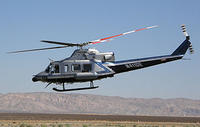-
Two companies offer tower-based border security systems
General Dynamics C4 Systems and EADS North America have joined forces to develop border protection and security systems which exploit the both companies’ strength; the team offers tower-based, integrated radar and sensor systems for an “always-on, ever-aware” picture of human activity in and around national borders
-
-
Space radiation detection technology to be used for homeland security
Common radioactive sources emit gamma rays while nuclear bomb material emits both gamma rays and neutrons; because neutrons and gamma rays are electrically neutral, it is difficult to ascertain properties such as the direction of origin or energy level of the radioactive source; University of New Hampshire scientists are re-engineering instruments originally built for detecting radiation in space for homeland security purposes
-
-
New international plan to tackle cyber crime, make Internet safer
A new international plan to tackle cyber crime has been launched; the new research roadmap has been developed by leading international cyber security researchers along with industry and government experts, and it aims to help make the Internet of tomorrow a safe and secure platform which is vital for global economic growth and societal development
-
-
Military-grade mobile security for commercial markets
Cummings Engineering announced the release of SecureMobile 1.0, powered its proprietary SAIFE encryption technology
-
-
TeleCommunication Systems acquires next-generation 9-1-1 technology specialist microDATA GIS
The Federal Communications Commission (FCC) predicts that state and local governments will spend up to $1.2 billion over the next ten years for NG9-1-1 upgrades, with an additional $1.5 billion spent on recurring connectivity, hosting, and operations and maintenance; TeleCommunication Systems acquires microDATA GIS, a next-generation 9-1-1 technology specialist
-
-
New Facebook app detects pedophiles, criminals
Researchers have developed a new privacy solution for Facebook; the Social Privacy Protector (SPP), developed by Ben-Gurion University of the Negev (BGU) undergraduate students, can help parents adjust their children’s profiles in one click, prevent criminals from gathering valuable personal information, and keep teens safe from pedophiles
-
-
Advanced IED detectors save lives

Almost 60 percent of all coalition forces wounded or killed in Afghanistan since the start of the war in 2001 have been due to IEDs; to complicate matters, insurgents in Afghanistan have been increasingly constructing IEDs to circumvent simple metal detectors; some IEDs contain rudimentary materials such as wooden boards, foam rubber, and plastic containers; the finished product contains very little metal making it difficult for a traditional metal detector to pick up
-
-
USDA gives GenVec conditional approval for FMD vaccine for cattle
The USDA has issued a conditional license for GenVec’s foot-and-mouth disease (FMD) vaccine for use in cattle; GenVec’s cell line is capable of producing antigens without the use of the highly contagious FMD virus; because the vaccine is produced without using live or killed virus materials, it can be produced cost effectively in the United States and around the world
-
-
Fukushima disaster “a profoundly man-made disaster”: investigative commission
The commission investigating the Fukushima disaster of March 2011 concluded that although the combination of the tsunami and earthquake was unprecedented in its ferocity, the disaster was largely man-made because it was amplified by what came before it and what followed it; the disaster itself, the commission said, was sandwiched by practices and conduct which were the result of government-industry collusion and the worst conformist conventions of Japanese culture; the government, nuclear regulators, and Tepco, the plant operator, “betrayed the nation’s right to safety from nuclear accidents”
-
-
A third Bell 412 helicopter delivered to NYPD for counterterrorism missions

The NYPD dedicated many hours to designing the specifications of the department’s third Bell 412 to meet the diverse needs of the police department; one of the counterterrorism additions to the Bell 412 is a radiation detection system that can identify radiation signatures from an altitude of 200 feet in an effort to protect the city from nuclear bomb threats
-
-
NYPD AW119 fleet achieves 20,000 hour milestone
The NYPD has four AW119 helicopters in service; the department’s first AW119 entered service in 2004; the NYPD has become the worldwide law enforcement fleet leader, having achieved more than 20,000 flying hours on the fleet
-
-
A third Bell 412 helicopter delivered to NYPD for counterterrorism missions
The NYPD dedicated many hours to designing the specifications of the department’s third Bell 412 to meet the diverse needs of the police department; one of the counterterrorism additions to the Bell 412 is a radiation detection system that can identify radiation signatures from an altitude of 200 feet in an effort to protect the city from nuclear bomb threats
-
-
NYPD AW119 fleet achieves 20,000 hour milestone
The NYPD has four AW119 helicopters in service; the department’s first AW119 entered service in 2004; the NYPD has become the worldwide law enforcement fleet leader, having achieved more than 20,000 flying hours on the fleet
-
-
Feds give Colorado access to critical infrastructure info
The Homeland Security Infrastructure Program (HSIP) compiles about 500 layers of geographic features, including power plants and water pumps; it is managed by DHS, the Pentagon’s National Geospatial Intelligence Agency, and the U.S. Geological Survey; the data set is available to state first responders only when federal disasters are declared; DHS has now given Colorado access to the HSIP
-
-
Tasers do not cause cardiac complications: study

Tasers are commonly used by law enforcement personnel worldwide as an intermediate-force option to subdue and apprehend potentially dangerous or combative suspects; tasers function by delivering a series of very brief high-voltage, low-current electric pulses that result in pain, muscle contraction and inhibition of voluntary movement; taser shots to the chest are no more dangerous than those delivered to other body locations, according to a new study
-
- All
- Regional
- Water
- Biometrics
- Borders/Immig
- Business
- Cybersecurity
- Detection
- Disasters
- Government
- Infrastructure
- International
- Public health
- Public Safety
- Communication interoperabillity
- Emergency services
- Emergency medical services
- Fire
- First response
- IEDs
- Law Enforcement
- Law Enforcement Technology
- Military technology
- Nonlethal weapons
- Nuclear weapons
- Personal protection equipment
- Police
- Notification /alert systems
- Situational awareness
- Weapons systems
- Sci-Tech
- Sector Reports
- Surveillance
- Transportation
Advertising & Marketing: advertise@newswirepubs.com
Editorial: editor@newswirepubs.com
General: info@newswirepubs.com
2010-2011 © News Wire Publications, LLC News Wire Publications, LLC
220 Old Country Road | Suite 200 | Mineola | New York | 11501
Permissions and Policies
Editorial: editor@newswirepubs.com
General: info@newswirepubs.com
2010-2011 © News Wire Publications, LLC News Wire Publications, LLC
220 Old Country Road | Suite 200 | Mineola | New York | 11501
Permissions and Policies
